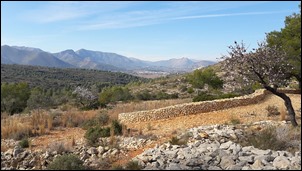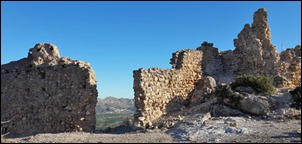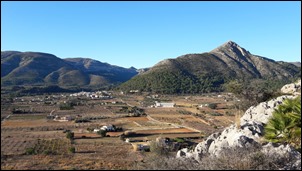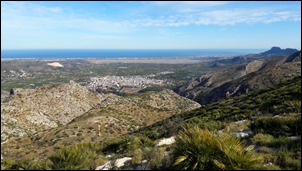[A more difficult pronunciation topic. Spanish Bs and Vs suffer from an identity crisis. They get mixed up. The pronunciation of Vinarós lies somewhere between Vin-a-ross and Bin-a-ross. The lead letter is a sort of soft B, made without the lips quite coming together. Tricky! Anyway …]
About 20kms up the coast from Peñíscola lies Vinarós. Today we piled into our car with our hosts and headed up for a squint. We bailed out in a handy-dandy car park and took to Shank’s Pony so we could wander along the promenade.
Shank’s Pony had trouble making it past the Ale-Hop shop. I should explain for the uninitiated that Ale-Hop is a chain of “gifts and gadgets” shops [I’d call it simply “tat”] fronted by a life-sized black and white cow on wheels. “Why a cow?”, I hear you ask. Well, I honestly don’t know; it beats the cowpat out of me. Those regarding shopping as an Olympic sport are irresistibly drawn to Ale-Hop shops, though. While the ladies indulged in a lengthy browse and bought a belt with expanding pockets that looked at least half-way useful, we guys stayed outside and looked for an irresistible tapas bar to delay Shanks’ Pony once again..
We found one and enjoyed a relaxing break sharing four tapas at the relaxing price of 90¢ each, once the ladies had taken their leave of the black and white cow.
 Tapas craving sated, we finished our promenade along the promenade before heading further into town. Imagine our surprise when, rounding a corner near the church, we were faced with a life-sized statue looking uncomfortably like a White Knight of the Ku Klux Klan. This particular effigy seemed to be stabbing himself in the right hip with a metal rod whilst leading a child, a child who was depicted looking up at him adoringly. Yikes! What’s all this? What’s the Ku Klux Klan doing in Spain? I must say that a damn good prolonged stabbing in the side with something sharp and pointy would be a perfectly good way to treat any member of the KKK. I couldn’t quite see them being as masochistic as they sadistic, though. We needed to do some research, clearly.
Tapas craving sated, we finished our promenade along the promenade before heading further into town. Imagine our surprise when, rounding a corner near the church, we were faced with a life-sized statue looking uncomfortably like a White Knight of the Ku Klux Klan. This particular effigy seemed to be stabbing himself in the right hip with a metal rod whilst leading a child, a child who was depicted looking up at him adoringly. Yikes! What’s all this? What’s the Ku Klux Klan doing in Spain? I must say that a damn good prolonged stabbing in the side with something sharp and pointy would be a perfectly good way to treat any member of the KKK. I couldn’t quite see them being as masochistic as they sadistic, though. We needed to do some research, clearly.
With some relief, back at Researchville, I discovered that the resemblance to the KKK appears to be superficial. In Spain, that distinctive pointed hood, the thing that really shouted KKK, is called a capirote and was worn by Catholic penitents, originally flagellants, who flogged themselves to do penance. I imagine, then, that this sharp, pointy stick is to do with self-inflicted pain for penance, too. Isn’t God a wonderful creation?
These days, the capirote is part of the costume of several brotherhoods and is worn during Easter observances, or Semana Santa as it is in the Catalan language of this part of Spain. Children, apparently, were allowed to wear a capirote only after their first holy communion when they could enter the brotherhood. Maybe that’s what’s going on with el niño above?
Perhaps the KKK usurped the capirote because of its use by brotherhoods?
 Getting away from the spooky costumes, the church in Vinarós displayed a couple of unusual features, too. Firstly, the main entrance was sided by heavy, dark, twisting columns. [‘Ello, dark and twisted – are we back to the KKK again?] I don’t recall seeing anything like these spiralling black columns before. I didn’t find them particularly attractive, more threatening. Still, I suppose if you’re heading into church with a spear in your side, looking threatening might be appropriate.
Getting away from the spooky costumes, the church in Vinarós displayed a couple of unusual features, too. Firstly, the main entrance was sided by heavy, dark, twisting columns. [‘Ello, dark and twisted – are we back to the KKK again?] I don’t recall seeing anything like these spiralling black columns before. I didn’t find them particularly attractive, more threatening. Still, I suppose if you’re heading into church with a spear in your side, looking threatening might be appropriate.
 Further round the church on the outside, the rear wall I think, was covered in what looked like a fresco. I’m used to frescos on inside walls but I’m sure I’ve not seen one on an external surface before.
Further round the church on the outside, the rear wall I think, was covered in what looked like a fresco. I’m used to frescos on inside walls but I’m sure I’ve not seen one on an external surface before.
Live and learn.




















Recent Comments